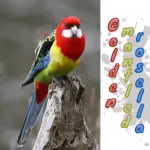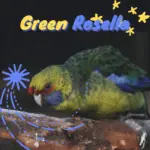
Northern Rosella 28 cm; mean 85 g. Bill whitish; head black except for off-white lower cheek and chin; underparts, lower back, and rump pale yellow lightly edged black, giving weak scaled effect; vent red;
nape, mantle, and scapulars black with broad pale yellow edges giving a strong scaled effect; lesser wing-coverts black, median coverts blue-grey, remaining wing-coverts black-edged yellow (inner) and blue-grey (outer ), primaries black;
tail bronze-green centrally, outer feathers dark blue shading paler to white tips. Northern Rosella Female similar. Immature duller and duskier, with scattered red in head, less red on vent.
Systematics History
Editor’s Note: This article requires further editing work to merge existing content into the appropriate Subspecies sections. Please bear with us while this update takes place.
Forms a species-group with P. ascites and P. eximius, and sometimes considered conspecific with both. Two subspecies were recognized.
Subspecies
Monotypic.
Distribution
N Australia and offshore islands from Barkly Tableland to King Sound.
Habitat
Eucalyptus and Melaleuca woodland in hilly country where access to water greater, plateau woodlands including those dominated by Callitris intertropical, occasionally visiting mangroves, parks, and gardens.
Movement
Probably mainly sedentary, although in dry season birds retreat to vicinity of watercourses.
SOURCE: Tim Siggs
Diet and Foraging
Northern Rosella Seeds of eucalypts, Melaleuca and Acacia, also C. intertropical; grass seeds and nectar also recorded. Birds in coastal woods sometimes feed on shorelines and creek banks.

Sounds and Vocal Behavior
The commonest call is a loud doubled or tripled “kwe-kweep!” or “kwe-kwee!-kwup” heard in flight. When perched, also a fast series of pure whistles, “wee-wee-wee-wee-wee” and squabbling phrases with a similar tonal quality to the flight call.
Breeding
Jun–Sept, sometimes earlier. Northern Rosella Nest in a hollow limb or hole in a tree, usually a eucalypt near water. Eggs 2–4; incubation lasts c. 19 days; nestling period c. 7 weeks.
Conservation Status

Not globally threatened. CITES II. Considered to be relatively uncommon overall, and only locally common. Evidence of former abundance is disputed,
so not clear if any decline has actually occurred since the mid-19th century, and in any case, no clear cause is discernible; possibly this species has always been limited by habitat, especially the availability of dry-season refuges.




















